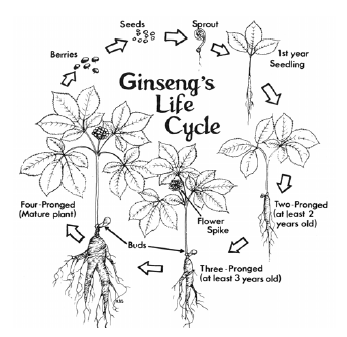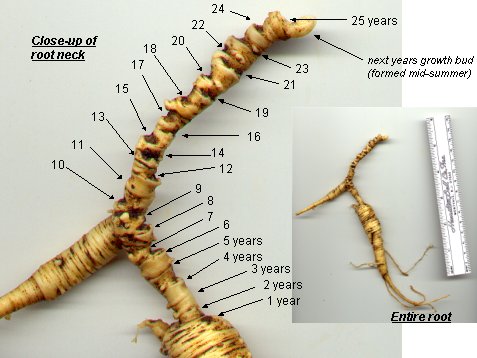There are a number of harvest practices that must be followed for a collector to be a ginseng steward:
GET PERMISSION TO HARVEST
Whether you are on private or public land, always get permission before digging ginseng. Some U.S. National Forests and State-owned lands will allow harvest of ginseng, but require you to obtain a permit. Harvest is not allowed in any National Park.
When digging on public land, always obtain required permits and comply with all rules. When digging on private property, get the permission of the landowner or his/her agent. Also, report any signs of property damage, habitat loss, or trespassing to the landowner.
RESPECT AMERICAN GINSENG'S LIFE CYCLE
American ginseng's lifecycle, as shown, illustrates the life stages of the plant. Seedlings have only 1 prong (leaf), which usually has 3 leaflets. The next phase has 2 prongs, with 3 or 5 leaflets per leaf. Mature plants have 3 or 4 prongs, each with 5 leaflets.

Researchers have estimated that each ginseng plant in the wild needs to produce over 30 seeds to replace each plant harvested. Never harvest seedling (1-prong) or juvenile (2-prong) plants, or plants that are less than 5 years old with at least 4 “bud scars” on the “neck” at the top of the root. Roots from younger plants are not allowed to be exported and many ginseng buyers won't buy these small roots, so it'd best to leave these plants in the woods for future harvest.

DIG SOME, LEAVE SOME
Good stewardship requires diggers to leave enough plants so that populations continue to be healthy and plentiful. Always leave some mature plants in every ginseng patch where you dig.
HARVEST ONLY IN THE HARVEST SEASON
The harvest season for wild ginseng varies by State. Make sure you know the legal State harvest season where you dig ginseng, and always comply with the State rules.
Never harvest plants before the fruit is ripe (red). This is a requirement in most States, and is an essential good stewardship practice.
PLANT RIPE FRUIT!!!
Experienced harvesters know to plant ginseng's red ripe berries as they dig for roots. This stewardship practice may explain why ginseng is still in the woods after three centuries of digging.
The best practice is to plant the ripe berries under ¾ to 1 inch of soil. Researchers have found that planting the ripe seeds at this depth can produce up to 8 times more seedlings!
PROTECT AMERICAN GINSENG'S HABITAT
Stewards of wild ginseng must care for the plants, as well as its native habitat.
Be aware of land-use and zoning activities in your community and join with local organizations to make your voice heard. Though landowners' property rights should be respected, make sure they are aware of the value of ginseng and other non-timber plants on their land.
OTHER STEWARDSHIP PRACTICES
Every ginseng steward should be aware of other stewardship practices, such as: • Record the number of plants in patches or populations before digging the roots, to see if the number of plants decrease, increase, or stay the same next year. Each year record your observation and any changes to the population. • After you dig some of the mature plants in a ginseng patch, and have planted all of the red fruits, break the stems off of any remaining plants so that other diggers don't take more roots from the same patch.
Information provided by American Herbal Product Associations

